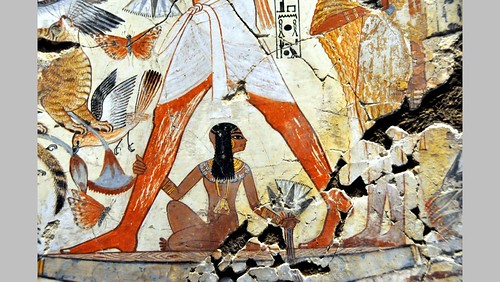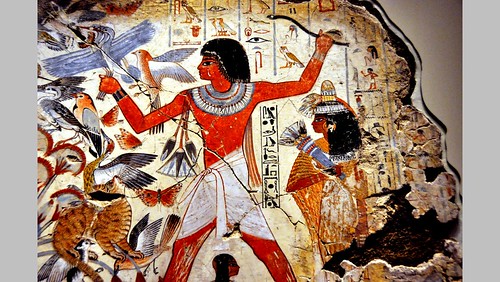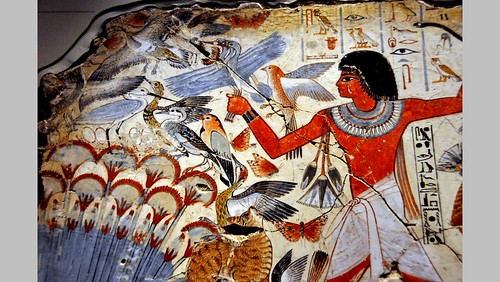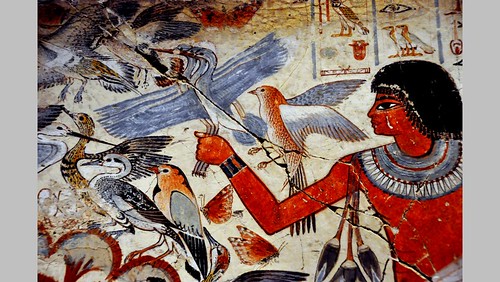

Cargado el 3 de julio, 2007
por Hans Ollermann
Nebamun

Image 66

Image 65

Image 64

Image 63

Image 62
Nebamun was an Egyptian "scribe and counter of grain" during the New Kingdom. His tomb in Thebes, the location of which is now lost, featured the famous Pond in a Garden false fresco painting.
Nebamun's name is translated as "My Lord is Amun" and he is thought to have lived c. 1500 bc. The paintings were hacked from the tomb wall and purchased by a British collector who in turn sold them to the British Museum in 1821. The collector died in poverty without ever revealing the source location of the paintings. The depictions are highly symbolic and thematically related to a joyful afterlife.
In 2009 the British Museum opened up a new gallery dedicated to the display of the restored eleven wall fragments from Nebamun's tomb, described as one of the Museum's greatest treasures. (Source: Wikipedia EncyclopediA)
See also my list of best and worst museums in the world:
www.flickr.com/photos/menesje/4059308291/
And here you find my list of best and worst museums in Holland:
www.flickr.com/photos/menesje/4059604700/
Hola a todos,
Aquí os dejo esta noticia,
Hola,
... Y aqui yo otra: recientes publicaciones por el Museo Britanico de Londres,
http://www.britishmuseum.org/research/online_journals/bmsaes/issue_13.aspx
que al estar en linea se pueden descargar y leer desde alli.
Saludos,
Roberto
Issue 13: November 2009
Editorial
BMSAES 13 contains 11 papers submitted for publication in the Proceedings of the Third International Colloquium on Predynastic and Early Dynastic Egypt, which was held at the British Museum from 27 July to 1 August 2008.
This selection from the more than 40 papers that will ultimately appear in the full proceedings “Egypt at its Origins 3” (Peeters’ Orientalia Lovaniensia Analecta series), touches on a wide range of topics and recent discoveries pertaining to this formative period is Egyptian history.
Potmarks were the subject of a special workshop during the conference and particular emphasis has been placed on them here in order to make these studies available as quickly as possible in the hope of generating further discussion of and interest in these still enigmatic markings. For further information please visit www.potmark-Egypt.com
In addition to prompt distribution, the 11 papers published herein also benefit from BMSAES’s online format, which has enabled us to reproduce numerous, high-quality images in full colour.
In particular, this format has made it possible to include the stunning photographs of the finds from Tell el-Farkha illustrating the contribution by Krzysztof Ciałowicz who delivered the 2008 Raymond and Beverly Sackler Foundation Distinguished Lecture in Egyptology.
The papers have been edited by Renée Friedman and Liam McNamara, both for this online publication and the eventual hard copy publication. Elisabeth O’Connell has edited the papers to conform to BMSAES style guidelines.
The full conference program and abstracts of papers presented are available at: www.origins3.org.uk/index.html
Renée Friedman
Elisabeth R. O’Connell
Contents
Pottery production at Hierakonpolis during the Naqada II period: Toward a reconstruction of the firing technique
Masahiro Baba
Institute of Egyptology, Waseda University, Tokyo, Japan
South Levantine Early Bronze Age chronological correlations with Egypt in light of the Narmer serekhs from Tel Erani and Arad: New interpretations
Eliot Braun
W. F. Albright Institute of Archaeological Research, Jerusalem, Israel and Centre de Recherche Français de Jérusalem, Israël
The corpus of pre-firing potmarks from Adaïma (Upper Egypt)
Gaëlle Bréand
EHESS-CRPPM, CNRS UMR 5608 “TRACES,” Toulouse, France
The development and nature of inequality in early Egypt
Juan José Castillos
Uruguayan Institute of Egyptology, Montevideo, Uruguay
The Early Dynastic administrative-cultic centre at Tell el-Farkha
Krzysztof M. Ciałowicz
Institute of Archaeology, Jagiellonian University, Kraków, Poland
Egypt and Nubia in the 5th–4th millennia BC: A view from the First Cataract and its surroundings
Maria Carmela Gatto
Yale University, New Haven, USA
Burial practices of the Final Neolithic pastoralists at Gebel Ramlah, Western Desert of Egypt
Michał Kobusiewicz, Jacek Kabaciński, Romuald Schild, Joel D. Iris and Fred Wendorf
Egyptian engineering in the Early Dynastic period: The sites of Saqqara and Helwan
Angela La Loggia
Macquarie University, Sydney, Australia
The corpus of potmarks from Tarkhan
Lisa Mawdsley
Centre for Archaeology and Ancient History, Monash University, Victoria, Australia
Investigating a new Dynasty 2 necropolis at South Saqqara
Ilona Regulski
Netherlands-Flemish Institute in Cairo, Cairo, Egypt
Anna Wodzińska
Institute of Archaeology, University of Warsaw, Warsaw, Poland
http://www.britishmuseum.org/default.aspx
##########################################
RSS Feed de Amigos de la Egiptología
http://www.egiptologia.com/index.php?format=feed&TYPE=rss
##########################################
Boletín Informativo de AE (BIAE)
http://www.egiptologia.com/boletin-informativo-biae.html
Recomendamos: La Tierra de los Faraones
http://www.egiptologia.org
--------------------------------------------------------------
LISTA DE DISTRIBUCIÓN DE AMIGOS DE LA EGIPTOLOGÍA - AE
Gestión Altas-Bajas y consulta mensajes enviados:
http://www.egiptologia.com/lista-de-distribucion.html
Moderador: Víctor Rivas egiptologia@egiptologia.com
Amigos de la Egiptología: http://www.egiptologia.com
Los mensajes de Amigos de la Egiptología son distribuidos gracias al apoyo y colaboración técnica de RedIRIS Red Académica Española - http://www.rediris.es
Beware ! The Egyptian Museum in Cairo has decided to ban camera's . Not so the good old British Museum, where visitors receive a warm welcome by enjoying the freedom of taking pictures. Here you see some pictures that I recently made of the Nebamon exposition in the British Museum, London.
Nebamun was an Egyptian "scribe and counter of grain" during the New Kingdom. His tomb in Thebes, the location of which is now lost, featured the famous Pond in a Garden false fresco painting.
Nebamun's name is translated as "My Lord is Amun" and he is thought to have lived c. 1500 bc. The paintings were hacked from the tomb wall and purchased by a British collector who in turn sold them to the British Museum in 1821. The collector died in poverty without ever revealing the source location of the paintings. The depictions are highly symbolic and thematically related to a joyful afterlife.
In 2009 the British Museum opened up a new gallery dedicated to the display of the restored eleven wall fragments from Nebamun's tomb, described as one of the Museum's greatest treasures. (Source: Wikipedia EncyclopediA)
See also my list of best and worst museums in the world:
www.flickr.com/photos/menesje/4059308291/
And here you find my list of best and worst museums in Holland:
www.flickr.com/photos/menesje/4059604700/

No hay comentarios:
Publicar un comentario